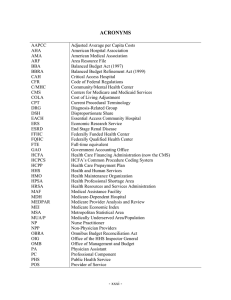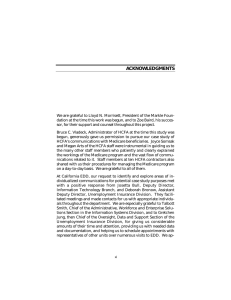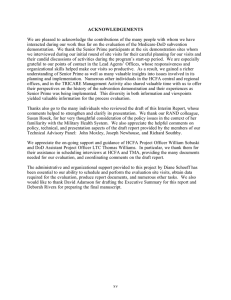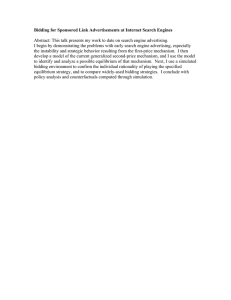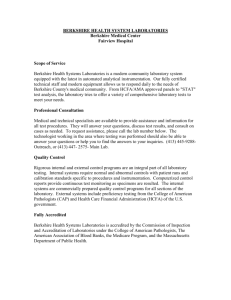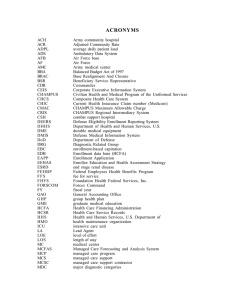Microscope on Washington
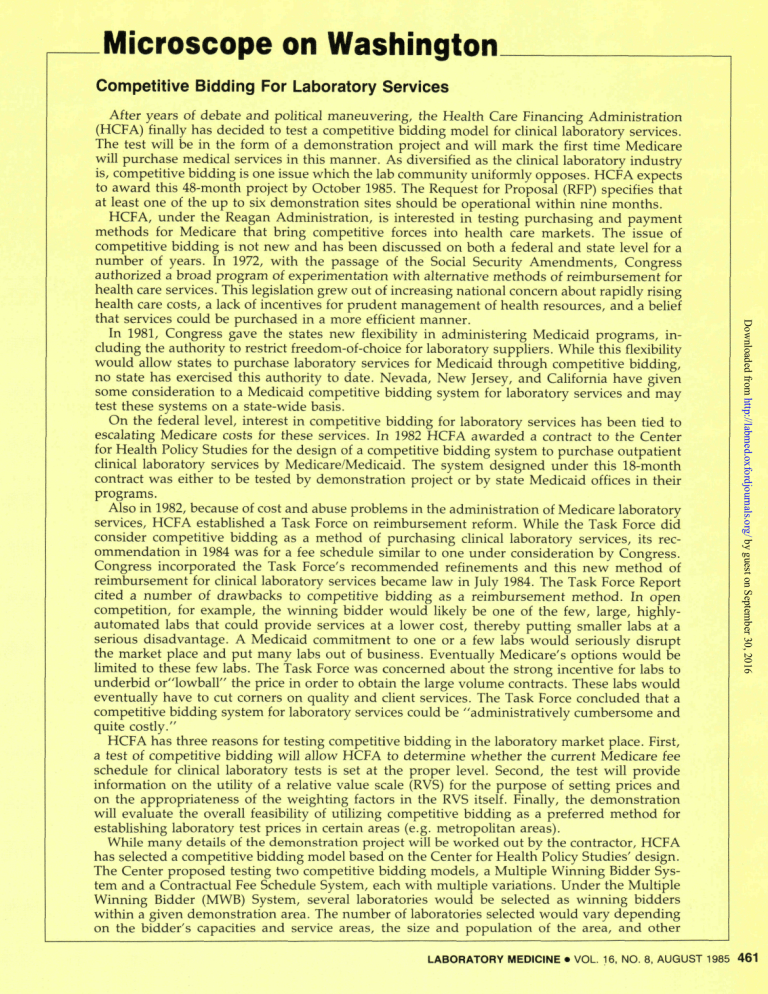
-Microscope on Washington
Competitive Bidding For Laboratory Services
After years of debate and political maneuvering, the Health Care Financing Administration
(HCFA) finally has decided to test a competitive bidding model for clinical laboratory services.
The test will be in the form of a demonstration project and will mark the first time Medicare will purchase medical services in this manner. As diversified as the clinical laboratory industry is, competitive bidding is one issue which the lab community uniformly opposes. HCFA expects to award this 48-month project by October 1985. The Request for Proposal (RFP) specifies that at least one of the u p to six demonstration sites should be operational within nine months.
HCFA, under the Reagan Administration, is interested in testing purchasing and payment methods for Medicare that bring competitive forces into health care markets. The issue of competitive bidding is not new and has been discussed on both a federal and state level for a number of years. In 1972, with the passage of the Social Security Amendments, Congress authorized a broad program of experimentation with alternative methods of reimbursement for health care services. This legislation grew out of increasing national concern about rapidly rising health care costs, a lack of incentives for prudent management of health resources, and a belief that services could be purchased in a more efficient manner.
In 1981, Congress gave the states new flexibility in administering Medicaid programs, including the authority to restrict freedom-of-choice for laboratory suppliers. While this flexibility would allow states to purchase laboratory services for Medicaid through competitive bidding, no state has exercised this authority to date. Nevada, New Jersey, and California have given some consideration to a Medicaid competitive bidding system for laboratory services and may test these systems on a state-wide basis.
On the federal level, interest in competitive bidding for laboratory services has been tied to escalating Medicare costs for these services. In 1982 HCFA awarded a contract to the Center for Health Policy Studies for the design of a competitive bidding system to purchase outpatient clinical laboratory services by Medicare/Medicaid. The system designed under this 18-month contract was either to be tested by demonstration project or by state Medicaid offices in their programs.
Also in 1982, because of cost and abuse problems in the administration of Medicare laboratory services, HCFA established a Task Force on reimbursement reform. While the Task Force did consider competitive bidding as a method of purchasing clinical laboratory services, its recommendation in 1984 was for a fee schedule similar to one under consideration by Congress.
Congress incorporated the Task Force's recommended refinements and this new method of reimbursement for clinical laboratory services became law in July 1984. The Task Force Report cited a number of drawbacks to competitive bidding as a reimbursement method. In open competition, for example, the winning bidder would likely be one of the few, large, highlyautomated labs that could provide services at a lower cost, thereby putting smaller labs at a serious disadvantage. A Medicaid commitment to one or a few labs would seriously disrupt the market place and put many labs out of business. Eventually Medicare's options would be limited to these few labs. The Task Force was concerned about the strong incentive for labs to underbid or"lowball" the price in order to obtain the large volume contracts. These labs would eventually have to cut corners on quality and client services. The Task Force concluded that a competitive bidding system for laboratory services could be "administratively cumbersome and quite costly."
HCFA has three reasons for testing competitive bidding in the laboratory market place. First, a test of competitive bidding will allow HCFA to determine whether the current Medicare fee schedule for clinical laboratory tests is set at the proper level. Second, the test will provide information on the utility of a relative value scale (RVS) for the purpose of setting prices and on the appropriateness of the weighting factors in the RVS itself. Finally, the demonstration will evaluate the overall feasibility of utilizing competitive bidding as a preferred method for establishing laboratory test prices in certain areas (e.g. metropolitan areas).
While many details of the demonstration project will be worked out by the contractor, HCFA has selected a competitive bidding model based on the Center for Health Policy Studies' design.
The Center proposed testing two competitive bidding models, a Multiple Winning Bidder System and a Contractual Fee Schedule System, each with multiple variations. Under the Multiple
Winning Bidder (MWB) System, several laboratories would be selected as winning bidders within a given demonstration area. The number of laboratories selected would vary depending on the bidder's capacities and service areas, the size and population of the area, and other
LABORATORY MEDICINE • VOL. 16, NO. 8, AUGUST 1985 4 6 1
factors. A sufficient number of laboratories would be selected to insure that physicians and
Medicare beneficiaries have a choice of laboratories and enough capacity to handle all of the
Medicare business in the area.
Under the Contractual Fee Schedule (CFS) System, the bidding system sponsor is required to offer a contract with all Medicare certified laboratories to provide services to Medicare beneficiaries at an announced price. Contracting laboratories select themselves as "winning bidders" under this system by agreeing in a contract to accept the amount specified in the fee schedule. Because of the similarity of this model to the current clinical lab fee schedule, HCFA has decided not to test it.
HCFA has elected to test one variation of the Multiple Winning Bidder (MWB) model, but has left it to the contractor to choose among five payment options and to decide whether to test more than one of those options. The MWB model has two prominent features: (1) all payment options are exclusionary, that is, both non-winning laboratories and beneficiaries who use non-winning labs will not be reimbursed; and (2) physicians who accept assignment for all
Medicare cases, that is, fully participate for laboratory work, will be paid at the winning bid price. Laboratory work done by non-winning hospital laboratories for hospital outpatients would be reimbursed at winning laboratory prices.
The demonstration's competitive process will rely upon an " o p e n " bidding strategy to solicit bids. Potential bidders in the process are all Medicare certified independent or hospital laboratories. The primary selection criterion for "winning bidders" is price. Final selection of winning bidders will be made by HCFA, not the contractor. Three of the payment options under this MWB model entail the direct use of relative value scale (RVS). Under these options, a laboratory submits one bid price (price factor), which is then applied to the RVS and used as the basis of payment for laboratory tests under the system. The other two payment options require that laboratories offer individual prices for laboratory tests under the system. The prices submitted under these options are to be evaluated by comparing them to an RVS in order to discern any major discrepancies, and by pricing out a fixed volume and mix of services using each bidder's price list and determining an average cost per test.
Since the development of an RVS is an essential component to this demonstration, the contractor must move quickly to develop it. The RVS should reflect actual relativities in prices being charged by laboratories within the selected demonstration sites and therefore could be developed from actual laboratory price schedules used for physician accounts by national and regional laboratories. HCFA is particularly interested in the feasibility of using the current reimbursement methodology (clinical lab fee schedule) as the basis of the RVS to be developed for this demonstration. If it is possible to develop an RVS from an area's prevailing charges, HCFA may use this method in its development of a national fee schedule for clinical laboratory services provided by independent and physician office laboratories, which is mandated for 1987 by the
1984 Deficit Reduction Act.
The contractor will select a maximum of six locations for the demonstration project. HCFA advises that a variety of locations be selected based on a number of local characteristics including: (1) the number of labs; (2) the extent of price competition in the local lab industry; (3) the presence of national or regional laboratories in the market; (4) the extent of local pathologist domination of the market; (5) the amount of hospital laboratory activity; and (6) the number of physician office laboratories.
This four-year study is divided into three phases. Within the first 12 months, or phase I,
HCFA expects the contractor to design and begin implementation of the project. Phase II is the actual demonstration and will last 24 months. The contractor can choose either an annual or biannual bidding solicitation process for this phase. Phase III is the evaluation of the demonstration and is to be completed in the final 12 months.
In the evaluation phase, quality will be assessed by comparing changes in numbers or types of deficiencies in laboratory performance based on historical data from proficiency testing and onsite inspection. Timeliness of testing, access to services by physicians and beneficiaries, and general physician satisfaction will be evaluated from surveys.
Aside from cost savings for Medicare, this demonstration will hold serious implications for the laboratory community even if it is never tried on a national scale. HCFA states that "these changes are likely to significantly affect relationships among physicians, independent laboratories and hospital laboratories" and that they will "have some impact on the historical structure of the laboratory industry". Certainly, such a radical change in reimbursement for laboratory services will not go without a legal challenge in the course of the demonstration.
4 6 2 LABORATORY MEDICINE • VOL. 16, NO. 8, AUGUST 1985
